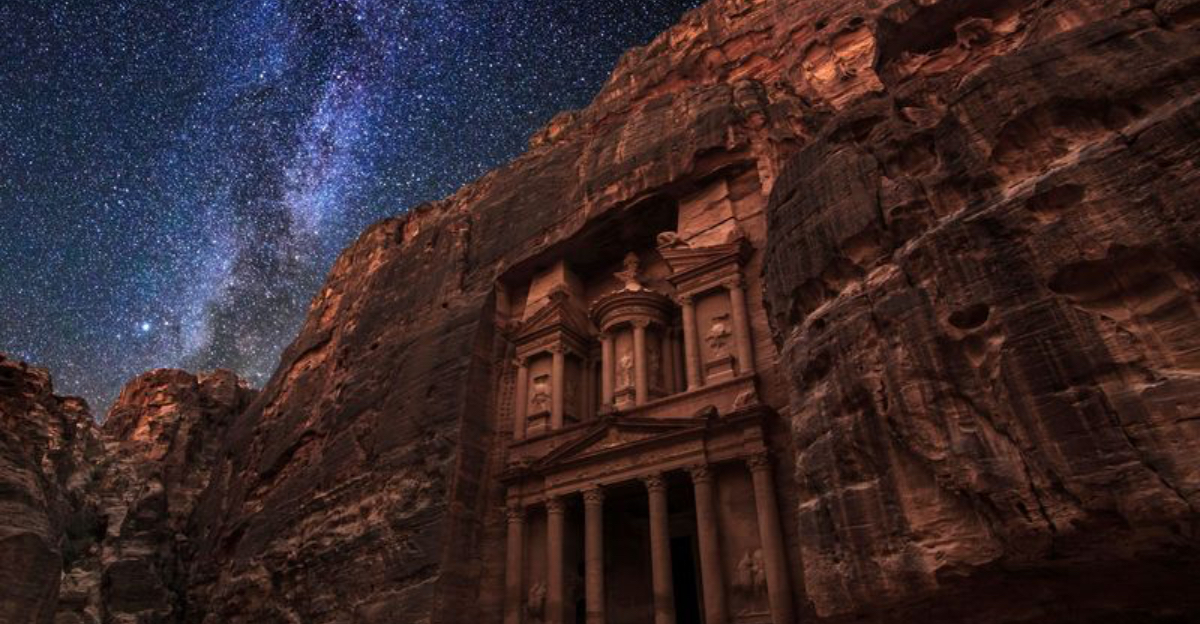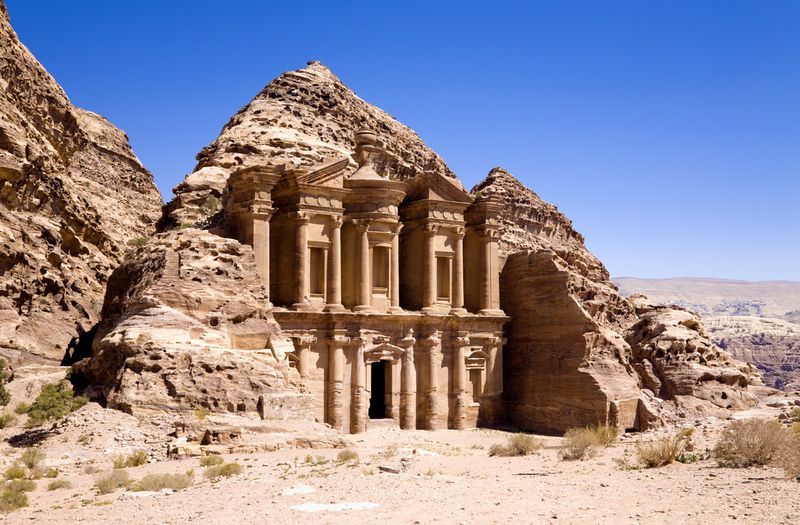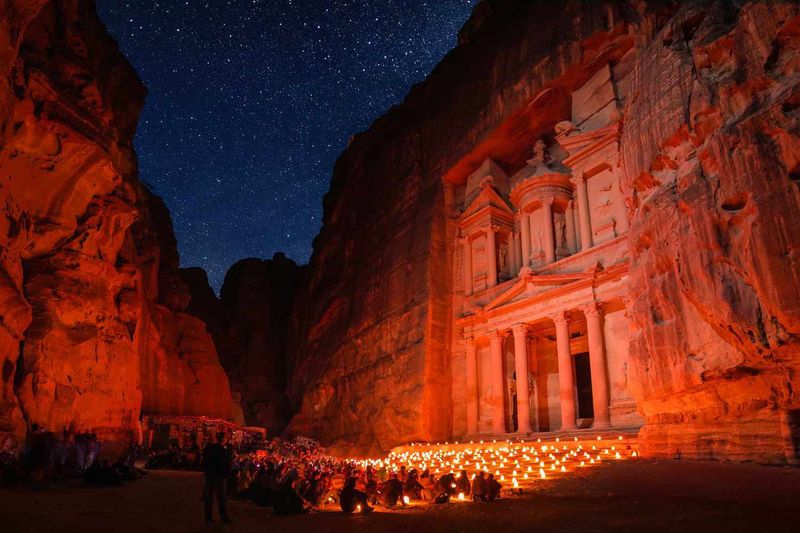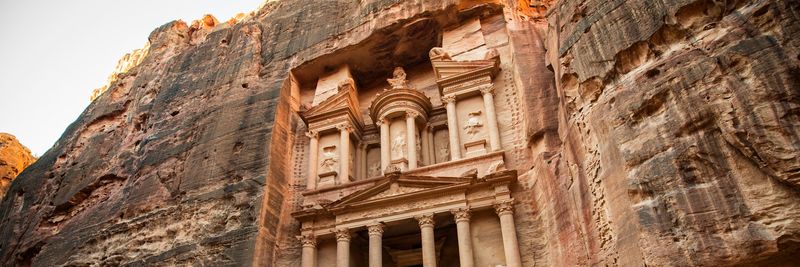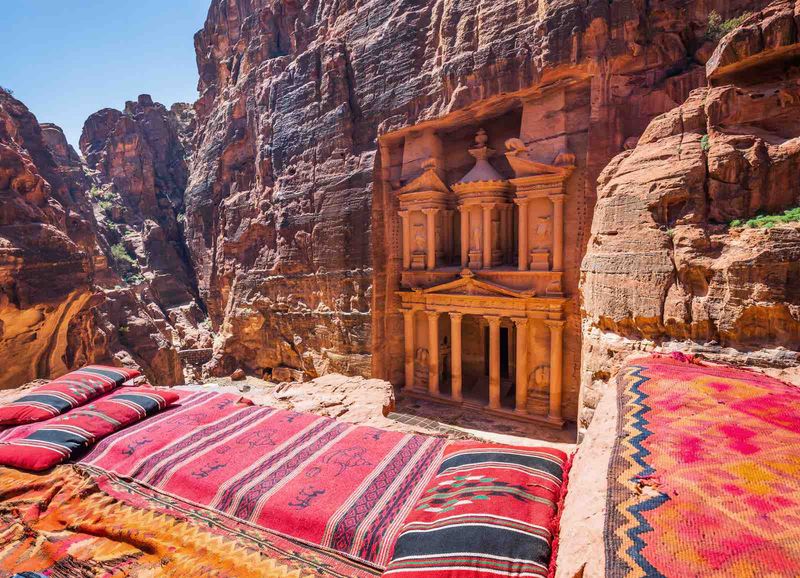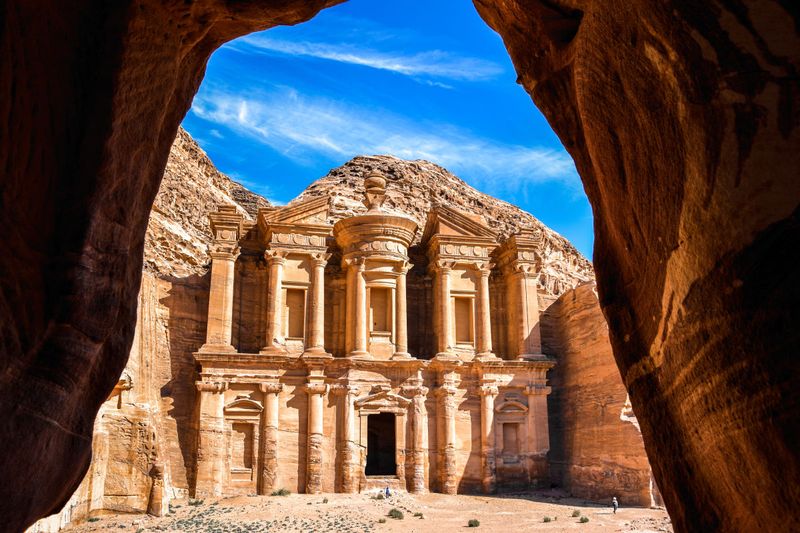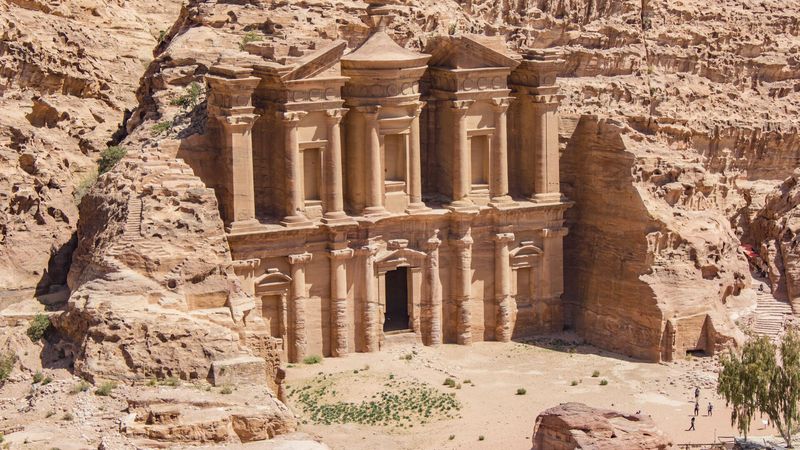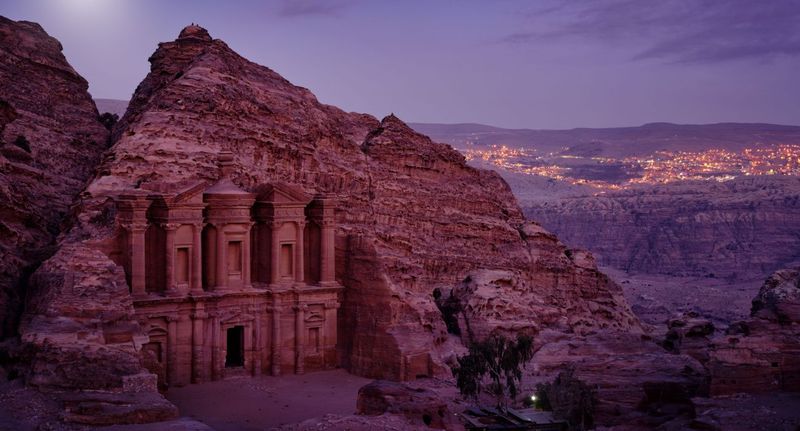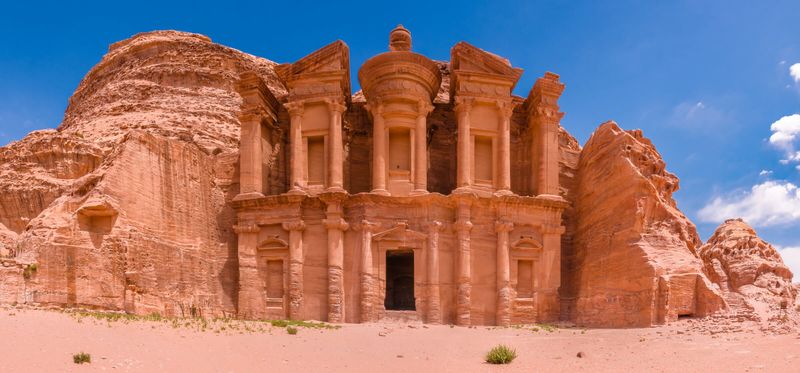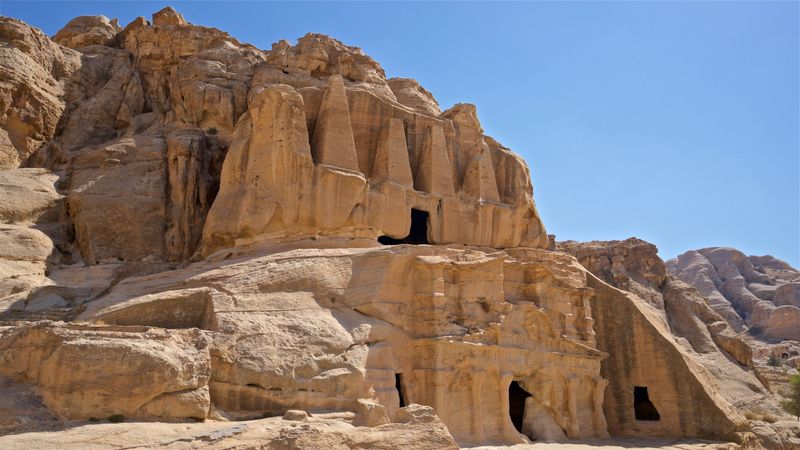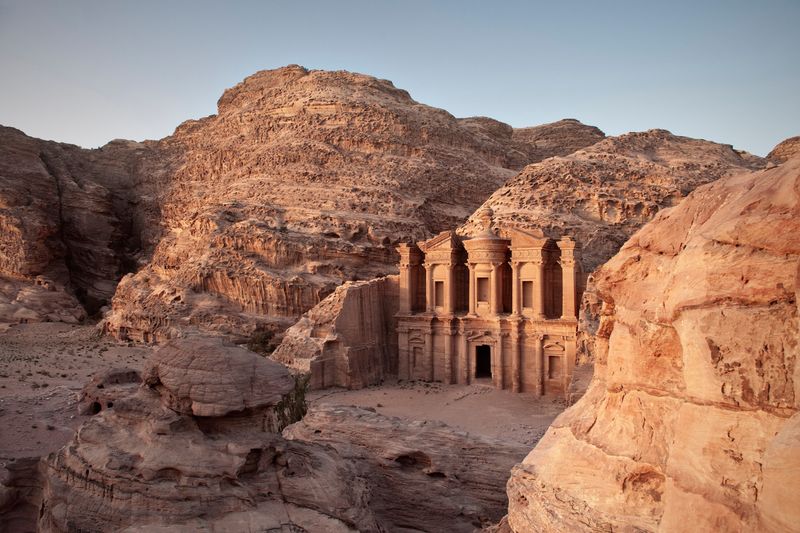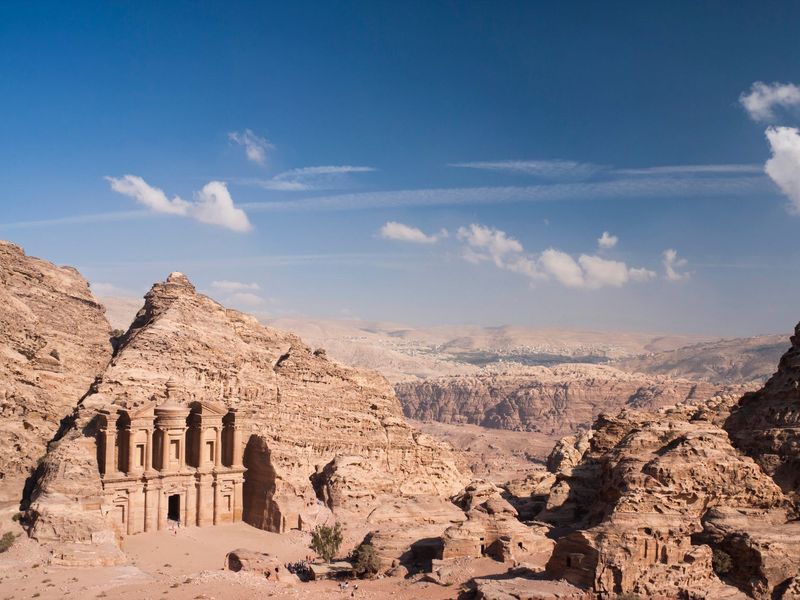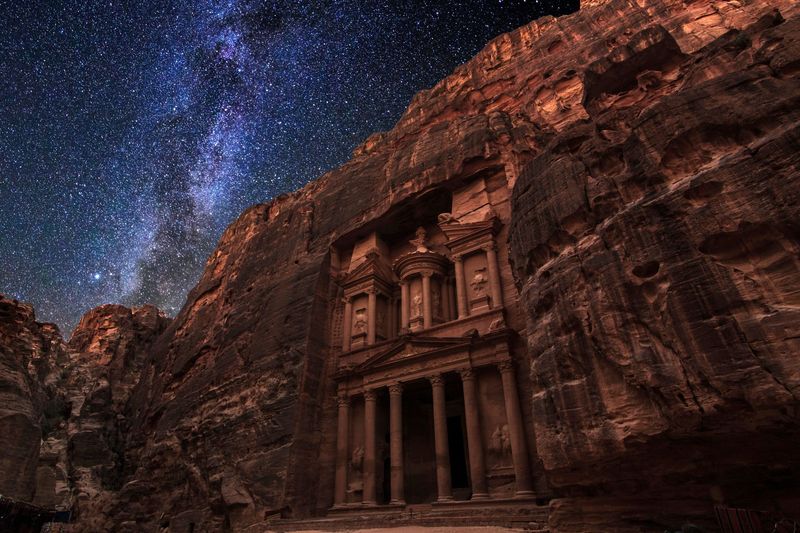Petra, often referred to as the “Rose City” for its stunning pink-hued sandstone cliffs, is a marvel of ancient engineering and artistry. Nestled in the rugged mountains of southern Jordan, this archaeological wonder offers a glimpse into the ingenuity and culture of the Nabataean civilization. Join us on a journey through twelve fascinating facts about this iconic UNESCO World Heritage Site.
The Rose City
Petra’s nickname, the “Rose City,” aptly describes the blush-pink hues of its sandstone cliffs. These cliffs transform with the sun’s journey, transitioning from deep red to soft pink hues. This natural wonder creates a breathtaking backdrop for the ancient city, making it a photographer’s paradise.
Visitors often find themselves mesmerized by the changing colors, as each shift in light offers a new perspective on the historic landscape. The captivating colors of Petra serve as a reminder of nature’s artistry and the timeless allure of this UNESCO World Heritage Site.
The Treasury
The Treasury, or Al-Khazneh, is Petra’s most iconic monument. Carved into the sandstone cliff, it features intricate Corinthian columns and mysterious carvings. This grand facade was once thought to house treasures, hence its name.
Ancient Nabataeans showcased their architectural prowess in creating such a masterpiece, blending Hellenistic and Eastern influences. Visitors are often struck by its grandeur, imagining the bustling life of ancient Petra. Standing before the Treasury, one can feel the echoes of history, witnessing a testament to human ingenuity and creativity.
The Siq
The Siq, a narrow gorge, serves as the dramatic entrance to Petra. Stretching approximately 1.2 kilometers, this winding path is flanked by towering rock walls, standing over 80 meters high. Walking through the Siq is an unforgettable experience, as the anticipation builds with each step.
Natural forces sculpted this passage over millennia, revealing vibrant rock layers. As visitors traverse the Siq, they encounter ancient carvings and niches, offering glimpses into Petra’s past. The Siq’s grandeur culminates in the awe-inspiring sight of the Treasury, making the journey truly magical.
Nabataean Ingenuity
The Nabataeans, who founded Petra, were masters of engineering and hydraulics. They devised an intricate water management system, including channels, dams, and cisterns, to sustain life in the arid desert environment. This ingenuity allowed them to thrive where others could not.
Their advanced techniques enabled agriculture and supported a significant population. Visitors today can witness remnants of these systems, marveling at the Nabataeans’ ability to manipulate their environment. The legacy of their innovation remains a testament to their skill and vision, demonstrating how ancient peoples overcame environmental challenges.
Petra’s Amphitheatre
Petra’s amphitheatre is a testament to the city’s vibrant cultural life. Carved directly into the rock, it could seat over 6,000 spectators, showcasing the grandeur of Nabataean society. Its design reflects Roman influences, highlighting cultural exchanges.
This venue hosted various events, from theatrical performances to public gatherings, serving as a hub of social interaction. Visitors can explore the amphitheatre’s remains, imagining the lively atmosphere of ancient times. Its acoustics and construction reveal the advanced understanding of architecture, making it a fascinating site for history enthusiasts.
The Monastery
Ad Deir, or the Monastery, rivals the Treasury in grandeur. Perched atop a mountain, reaching it requires a hike of over 800 steps. The reward is a stunning facade, similar in style to the Treasury but larger in scale.
Its purpose remains a mystery, though it likely served religious or ceremonial functions. The Monastery’s commanding position offers breathtaking views of Petra’s landscape, making the journey worthwhile. Visitors often reflect on the effort to carve such structures, marveling at the Nabataeans’ dedication and skill in creating these monumental works.
Petra’s Tombs
Petra is home to hundreds of rock-cut tombs, reflecting the Nabataeans’ beliefs in the afterlife. The facades vary in style, from simple to elaborate, showcasing a blend of cultural influences.
Many tombs bear inscriptions and graffiti, offering insights into the daily lives and thoughts of ancient inhabitants. Exploring these tombs provides a fascinating glimpse into the past, revealing the Nabataeans’ craftsmanship and aesthetic sensibility. Visitors are drawn to the rich history embedded in these structures, pondering the stories of those who once lived and thrived in this ancient city.
High Place of Sacrifice
The High Place of Sacrifice sits atop a mountain, offering panoramic views of Petra. This sacred site features an altar, likely used for religious rituals and offerings, reflecting the spiritual practices of the Nabataeans.
Reaching this site involves a steep climb, but the breathtaking vistas and serene atmosphere make it worthwhile. Visitors often pause to reflect upon the spirituality and reverence of ancient times, connecting with the past through the landscape. The journey to the High Place is both a physical and spiritual adventure, enriching the Petra experience.
Petra’s Obelisk Tomb
The Obelisk Tomb is named for its distinctive obelisk-shaped pillars. This unique architectural feature illustrates Egyptian influence, highlighting Petra’s role as a cultural crossroads.
The tomb’s facade, with its blend of styles, exemplifies the Nabataeans’ openness to external influences. Visitors are captivated by the elegance and symbolism of the obelisks, pondering their significance. Exploring the Obelisk Tomb offers a deeper understanding of Petra’s diverse heritage, inviting reflection on the cultural exchanges that shaped this ancient city. Its striking design remains a highlight for those exploring Petra.
Petra’s Roman Influence
Roman influence is evident in Petra, particularly along the colonnaded street. This thoroughfare, lined with columns, reflects the city’s integration into the Roman Empire and the blending of cultures.
Walking this street, visitors can imagine the bustling markets and social interactions of ancient times. The blend of Roman and Nabataean elements illustrates the city’s dynamic history, offering insights into the cultural and economic exchanges. Exploring this area allows a glimpse into the daily life and urban planning of Petra, highlighting its significance as a cultural melting pot.
Petra’s Modern Discovery
Petra was lost to the Western world for centuries until Swiss explorer Johann Ludwig Burckhardt rediscovered it in 1812. Disguised as an Arab, Burckhardt journeyed through Jordan, unveiling Petra’s forgotten wonders to the world.
His discovery sparked global interest in Petra, leading to further exploration and preservation efforts. Visitors today owe much to Burckhardt’s adventurous spirit and dedication to uncovering the past. His story adds a layer of intrigue to Petra’s history, reminding us of the explorers who bridged cultures and expanded our knowledge of ancient civilizations.
Petra by Night
Petra by Night offers a magical experience, where the ancient city is illuminated by thousands of candles. The journey begins with a walk through the Siq, lit by candlelight, leading to the Treasury.
The atmosphere is enchanting, as traditional music echoes between the cliffs. This event allows visitors to experience Petra in a unique and intimate way, connecting with its history under the starry sky. The blend of natural beauty and cultural heritage creates a memorable experience, leaving a lasting impression of wonder and awe. Petra by Night captivates all who visit.
